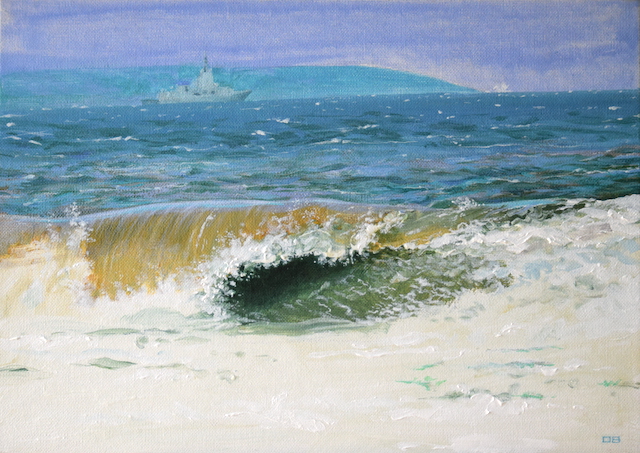
Jervis Bay NSW
It’s hard to imagine what it would be like bobbing around in a tin boat on a cold winter day, but this is sort of what it looks like. After almost a week of heavy rain, wind, and generally belligerent weather one of our destroyers turned up in the bay sitting as they often do just off the Beecroft peninsular that forms the north eastern shore of Jervis Bay. Sometimes they moor down near the naval college on the southern shore of the bay.
After a day or two the ships disappear, to who knows where. Considering the shallow nature of the bay I’ve often wondered where they find the depth to avoid running aground.
Painting waves is something of a challenge at the best of times but after storms the run-off from the local creeks turn the waters of the bay into a green-brown soup and with a bit of extra swell the result is a lot of ‘ice-cream’ as I like to call it. This bubbling brew of foam and seaweed with the odd tree trunk or branch that has washed out of the creeks [often with a few drowned native animals unfortunately] can take weeks to wash the beach clean again.
The additional size of the swell produced by storm activity loads waves with a lot more power than your normal sunny days holiday playground type wave activity, so discretion is the better part of valour if you want to keep your body in one piece. Of course, most young people don’t care about this concern of mine, but I’m a big wave chicken after several nasty run-ins with some very big waves when I was young.
I washed the basic sections of the composition in first, trying to get some sense of colour and value, then quickly brushed in the colour behind the main area of activity, the curl of the wave (the bit you don’t want to get smashed by) and the foamy wash in the foreground. At this stage it’s very rough, produced with a No. 8 flat hog bristle brush.
Once I decided I was on the right track I set about deciding if I could use some areas of that broad brushwork in the final work. In this painting, that included most of the foreground “ice-cream”, the left and right ends of the wave and the sky and peninsular at the top. The sky is almost an untouched original wash. I like to think the viewers eye is more than capable of fooling their brain into making up the detail – I might be delusional too! However, it works for me so I’m happy to try it.
There is one caveat to this method of creating a painting – those sketchy rough areas must contribute, must seem almost a natural part of the completed picture… I can decide but only you can tell if this works.